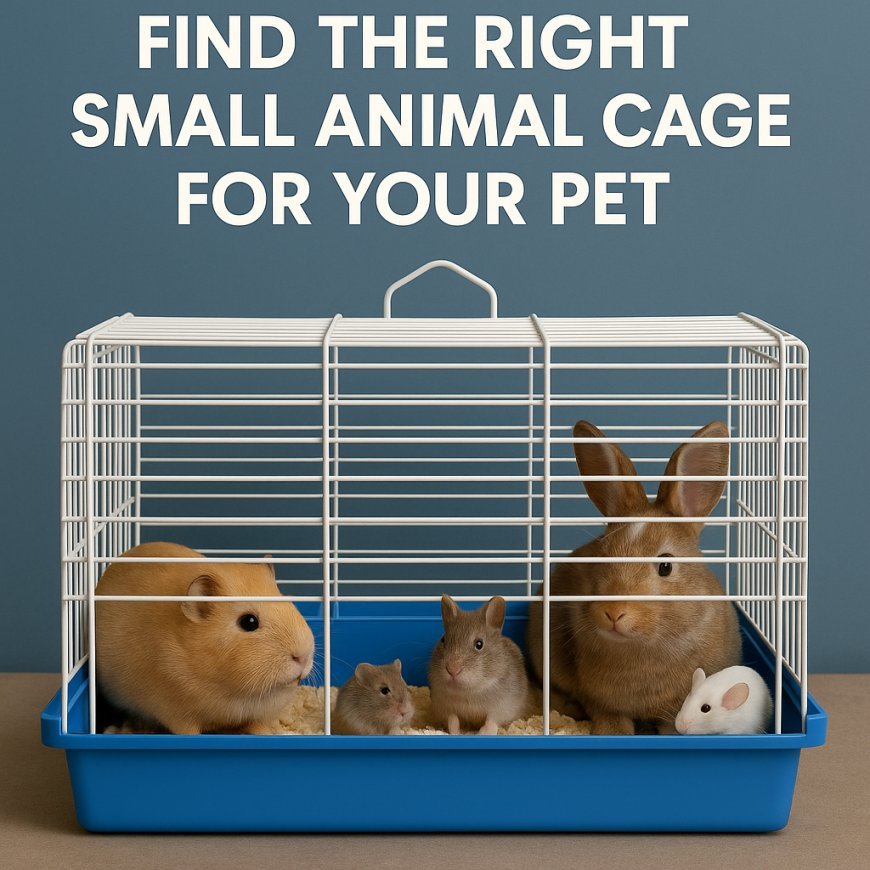The Importance of the Right Small Animal Cage Setup

When it comes to caring for small pets such as hamsters, guinea pigs, rabbits, and ferrets, the environment you provide plays a vital role in their health and happiness. A well-designed small animal cage is more than just a home — it’s a sanctuary that meets their physical, emotional, and behavioral needs.
Choosing and setting up the best small animal cages involves more than picking an attractive enclosure. Factors such as size, ventilation, ease of cleaning, and enrichment opportunities impact your pet’s quality of life. For pet parents in the USA, this guide provides expert advice on selecting and setting up the ideal cage, ensuring your small animal thrives in comfort and safety.
Choosing the Best Small Animal Cage for Your Pet
Selecting the right cage begins with understanding your pet’s species-specific needs and lifestyle.
Cage Types and Materials
Small animal cages come in a variety of types and materials, each with advantages:
-
Wire Cages: Popular for rabbits and guinea pigs, wire cages offer excellent ventilation and visibility. Look for cages with solid plastic or metal bases to protect your pet’s feet.
-
Glass Tanks or Aquariums: Often used for hamsters and gerbils, these tanks provide escape-proof habitats but need proper ventilation to avoid humidity buildup.
-
Modular Habitats: These customizable cage systems feature interconnected tunnels and multiple levels, making them ideal for hamsters or ferrets that enjoy climbing and exploring.
-
Plastic Cages: Lightweight and easy to clean, plastic cages often feature multiple compartments and accessories, but ensure sufficient airflow.
The best small animal cages strike a balance between durability, safety, and comfort. Avoid cages with wide bars for smaller pets to prevent escapes or injuries.
Size and Space Requirements
Size matters for your pet’s health and happiness. As a general rule, bigger is better:
-
Hamsters: Minimum of 450 square inches of floor space. Bigger breeds, such as Syrians, require more space.
-
Guinea Pigs: At least 7.5 square feet for one guinea pig, with additional space for companions.
-
Rabbits: Minimum 12 square feet of enclosure space, plus daily time outside the cage.
-
Ferrets: Require tall cages with multiple levels for climbing and playing.
The cage should provide sufficient space for natural behaviors, such as running, burrowing, and stretching.
Essential Features of a Healthy Small Animal Cage
Ventilation and Safety
Proper airflow is critical in preventing respiratory issues. Wire cages naturally offer superior ventilation. For tanks or plastic cages, ensure there are adequate mesh tops or vents.
Safety features to consider:
-
Secure doors and locks to prevent escapes.
-
Non-toxic, chew-resistant materials.
-
Rounded corners and smooth edges to avoid injury.
Easy Cleaning and Maintenance
The best small animal cages for busy pet parents are those easy to clean. Removable trays and simple disassembly save time and reduce stress for pets during cleaning.
Look for cages resistant to odors and moisture buildup. Some modern cages include slide-out litter pans or pull-out trays for efficient waste removal.
Setting Up Your Small Animal Cage for Comfort and Enrichment
A cage isn’t just about containment; it should be a stimulating and cozy home.
Bedding and Flooring Options
Soft, absorbent bedding provides comfort and odor control. Options include:
-
Paper-based bedding: Dust-free, absorbent, and safe.
-
Aspen shavings: A natural wood bedding free of harmful oils found in pine or cedar.
-
Fleece liners: Reusable, washable, and gentle on feet, ideal for rabbits and guinea pigs.
Avoid bedding that’s dusty or scented, which can cause respiratory problems.
Hiding Spots and Nesting Areas
Small animals instinctively seek secure places to hide. Incorporate:
-
Wooden huts, tunnels, or fabric hideaways.
-
Nesting boxes filled with soft bedding for warmth.
These spots reduce stress and promote natural behaviors.
Toys and Accessories for Mental Stimulation
Mental enrichment keeps pets happy and healthy. Popular accessories include:
-
Exercise wheels sized for your species.
-
Chew toys to maintain dental health.
-
Tunnels, ramps, and climbing structures.
-
Foraging toys that encourage natural hunting or searching behavior.
Rotate toys regularly to maintain interest.
Tips for Cage Placement and Environment
Location matters. Place the cage in a quiet, well-lit area away from direct sunlight, drafts, and loud noises. Small animals are sensitive to temperature fluctuations, so maintaining a consistent, comfortable climate is key.
Avoid placing cages near kitchens or windows where fumes or predators like neighborhood cats may cause stress.
Latest Trends and Innovations in Small Animal Cages in the USA
The USA pet market embraces innovations that simplify care and boost pet welfare:
-
Modular Multi-Level Cages: Allow customization for climbing and exploration, especially for ferrets and rats.
-
Eco-Friendly Materials: Cages made from recycled plastics or sustainably harvested wood.
-
Smart Cages: Incorporating sensors to monitor temperature, humidity, and even pet activity remotely.
-
Enhanced Cleaning Systems: Cages designed for quick disassembly and dishwasher-safe components.
According to recent data from the American Pet Products Association (APPA), over 67% of USA small pet owners prefer modular or customizable cage systems that grow with their pets.
How to Maintain and Clean Your Small Animal Cage
Regular maintenance ensures a healthy living environment:
-
Daily: Remove uneaten food, spot-clean soiled bedding.
-
Weekly: Complete cage cleaning with pet-safe disinfectants.
-
Monthly: Deep cleaning of toys, hideouts, and accessories.
-
Check: Inspect for wear, damage, and replace unsafe items promptly.
Routine cleaning prevents disease, odor, and stress for your small pet.
FAQs About Small Animal Cages
1. What is the ideal size for a small animal cage?
The ideal size varies by species, but generally, the cage should allow your pet ample space to move, stretch, and express natural behaviors. Bigger cages are always better.
2. Which materials are safest for small animal cages?
Non-toxic plastics, stainless steel, powder-coated metal, and untreated wood are preferred. Avoid cages with sharp edges or toxic paints.
3. How often should I clean my small animal cage?
Spot-clean daily and perform a thorough cage cleaning once a week to maintain hygiene and minimize odors.
4. Can I use the same cage for different small animals?
No. Different species have varying needs in terms of size, ventilation, and accessories. Always select a cage appropriate for your specific pet.
5. Where can I find the best small animal cages in the USA?
Trusted online retailers, such as Chewy and Petco, as well as specialty pet stores, offer a wide selection. Always check reviews and ensure the cage fits your pet’s requirements.
Conclusion: Invest in the Best Small Animal Cage for Your Pet’s Well-being
Choosing the right small animal cage is foundational to providing a safe, comfortable, and enriching home for your tiny companion. The best small animal cages combine spacious design, quality materials, and thoughtful features that simplify your care routine while promoting your pet’s physical and mental health.
By selecting a cage tailored to your pet’s species, incorporating cozy bedding, enriching toys, and maintaining a clean environment, you create a nurturing space where your small animal can thrive. Staying informed on the latest trends and trusted USA pet supplies ensures you’re always providing the best.
Investing in the proper small animal cage setup today will reward you with years of joyful companionship and peace of mind.
What's Your Reaction?



























































